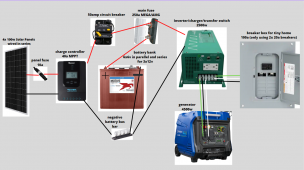andrewh
New Member
*originally posted this in "Newcomers" but moving in case that was the wrong place (can't figure out how to delete that one)*
Hello all,
I'm a beginner and would like to set up an off grid tiny home/cabin with solar power on an inverter/charger. Watched a few of Will's videos to get an idea of how to get things started and still learning a lot. The most I have done in the past is just set up and use of Goal Zero Yeti 1250 and, more recently, Bluetti's AC300 (after watching Will's video on that unit). Both of these systems are basically "plug and play" so not much research or setup involved.
Wanted to share my cabin power configuration on here to see if anyone could take a look and let me know if I am on the right track, if I might be missing something, any general recommendations, or if there might be any concerns with this setup. This is my first time doing anything like this, so any/all help is much appreciated.
The cabin will be used occasionally, someone may stay in there on and off for around a week at a time. The breaker box will be run to around 5 outlets and 3 lights (all 12/2 Romex inside). The purpose for the generator will be for occasional use of an electric stove and/or coffee maker, but also for charging the batteries if the weather turns cloudy for several days. A propane heater will be used in the winter, which does not connect to any power. The location is northern Arizona, so it stays sunny most of the year other than around July-September with monsoon season. The breaker box is oversized but we will only be using a couple breakers for two runs in the cabin. Anyone using the cabin will know not to use any high powered items without starting the generator first. As far as I can tell, this generator cannot be setup to auto start when batteries run low so a close eye will be kept on the charge levels and charged as needed (using Renogy 500A Battery Monitor with Shunt, High and Low Voltage Programmable Alarm).
Hopefully, I'm setting this up to be able to scale up in the future with additional solar panels and potentially use lithium batteries instead, but that might be quite some time out. The 6x Trojan T105 batteries that I am using were purchased for our RV but the originals are still going strong so I figured these could be setup to use in the cabin instead.
Please take a look at the below/attached configuration/notes and let me know your thoughts or if any other info might be helpful.
Thanks,
Andrew


Hello all,
I'm a beginner and would like to set up an off grid tiny home/cabin with solar power on an inverter/charger. Watched a few of Will's videos to get an idea of how to get things started and still learning a lot. The most I have done in the past is just set up and use of Goal Zero Yeti 1250 and, more recently, Bluetti's AC300 (after watching Will's video on that unit). Both of these systems are basically "plug and play" so not much research or setup involved.
Wanted to share my cabin power configuration on here to see if anyone could take a look and let me know if I am on the right track, if I might be missing something, any general recommendations, or if there might be any concerns with this setup. This is my first time doing anything like this, so any/all help is much appreciated.
The cabin will be used occasionally, someone may stay in there on and off for around a week at a time. The breaker box will be run to around 5 outlets and 3 lights (all 12/2 Romex inside). The purpose for the generator will be for occasional use of an electric stove and/or coffee maker, but also for charging the batteries if the weather turns cloudy for several days. A propane heater will be used in the winter, which does not connect to any power. The location is northern Arizona, so it stays sunny most of the year other than around July-September with monsoon season. The breaker box is oversized but we will only be using a couple breakers for two runs in the cabin. Anyone using the cabin will know not to use any high powered items without starting the generator first. As far as I can tell, this generator cannot be setup to auto start when batteries run low so a close eye will be kept on the charge levels and charged as needed (using Renogy 500A Battery Monitor with Shunt, High and Low Voltage Programmable Alarm).
Hopefully, I'm setting this up to be able to scale up in the future with additional solar panels and potentially use lithium batteries instead, but that might be quite some time out. The 6x Trojan T105 batteries that I am using were purchased for our RV but the originals are still going strong so I figured these could be setup to use in the cabin instead.
Please take a look at the below/attached configuration/notes and let me know your thoughts or if any other info might be helpful.
Thanks,
Andrew




